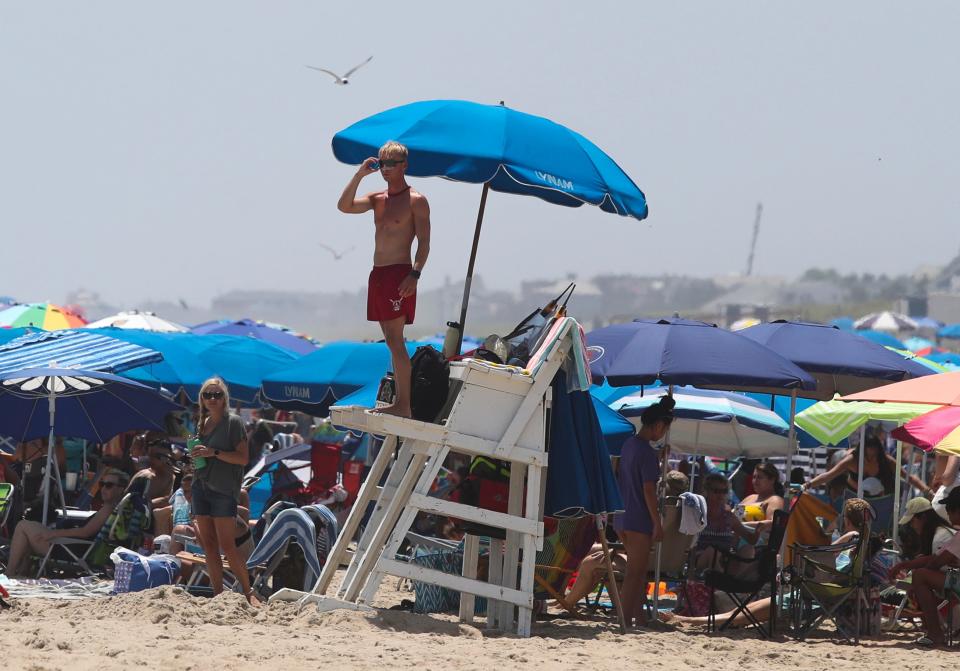There goes my umbrella! Here's how to stay safe when unexpected storms pop up at the beach
One minute you're sunbathing on the sand, feeling the cool sea breeze across your skin as you read a book or doze off to the sounds of fizzing and foaming waves along the surf.
Then, a dark ominous cloud seemingly comes out of nowhere. The winds pick up and the umbrellas around you start flipping inside out. Perhaps a clap of thunder makes you jump right out of that cozy beach chair you had just settled into moments before.
This is the unfortunate reality of sudden weather changes at the Delaware beaches, especially in the summertime.
And many beachgoers in the Bethany Beach area received a rude reminder of this sporadic weather just this past weekend.
HEAT:Buckle up, Delaware – it's getting hot again. What you need to know about this heat wave
On Friday afternoon, the National Weather Service sent out a special weather statement predicting 40-mph winds and possible pea-sized hail. Trent Davis, a meteorologist at the Mount Holly, New Jersey, station, said this type of advisory is like a “first stepping stone” to a severe thunderstorm warning.
But it wasn’t something to be ignored. Multiple beachgoers commented later on Facebook that the storm came earlier than expected and started intensifying as it got closer to the water − and “there was little you could do to get out of the way,” as one commenter put it.
Then, the umbrellas started flying. One visitor recorded a video from a porch at Sea Colony in Bethany Beach, and through the cloudy haze of wind and sand, dozens of umbrellas all rose up into the air and blew toward the ocean.
“It was sunny, then a slight drizzle, and most people stayed on the beach which is normal,” one person commented on Facebook. “Then all hell broke loose, instantaneously.”
A representative from Sea Colony said the community did not have a comment.
Crazy storm that came out of nowhere! Umbrellas went flying. hoping no one got hurt #bethanybeach #seacolony pic.twitter.com/waEZhFF82w
— hbcarter (@hbcarter) August 5, 2022
Others said people helped one another off the beach, and no one appeared to be injured as the umbrellas took off into the air.
Still, local meteorologists and lifeguards have said that sudden severe weather can put people at risk of injury, and they advise people to monitor water and weather conditions.
BEACH SAFETY:Those waves break harder than you think. Here's how to stay safe at Delaware and Maryland beaches
As you make more plans to soak up the remaining summer days on the beach, here’s what to know about why these storms can pop up without much warning and what you can do to avoid getting soaked or caught up in a windstorm.
What’s really behind this unpredictable weather?
Meteorologists at least partially blame the quick-changing weather forecasts on the sea breeze – yep, that attractive gust of wind that draws people to the coast on sizzling hot days.
For a thunderstorm to form, it needs some kind of instability or energy, as well as moisture, Davis explained, but it also needs something to get it going, or “kick start it.” That’s where the sea breeze comes in. This breeze can act as that catalyst by scooping up the air and initiating a storm.
Because of this, Davis said storms are often popping up along the coast like “clockwork” around the late morning and afternoon hours, especially if there is already some level of instability like an existing risk of thunderstorms.
WEATHER:How severe will this winter be in Delaware? The Farmers' Almanac issues its prediction.
The sea breeze essentially acts like a cold front and can bring in this more severe weather, according to the weather service.
The good news? As quickly as these storms arrive, they often move out of the area just as fast. So, if people can quickly find shelter in a building or their car, they can often return to the beach and enjoy the rest of the day.
While there have been fewer severe thunderstorm warnings throughout this year than in the past few years, Davis said, meteorologists have noted the phenomenon called “upwelling,” happening more frequently this year.

Similar to the physics that makes a storm spin, “upwelling” is when winds constantly blow from the south or southwest direction and, with the rotation of the Earth, cause the ocean water to be pulled away from the shore. Then, cooler water from below replaces that water along the coast.
This phenomenon can also make for prime conditions for a thunderstorm to quickly take hold, especially later in the summer when the risks of thunderstorms typically decline due to warming ocean temperature.
The National Weather Service has even reported a few drastic examples this year where the waters near Atlantic City dropped as much as 10 degrees due to this upwelling, Davis said.
What to know to avoid bad weather at the beach
The best advice for not letting thunderstorms ruin your beach trip? It’s pretty simple: Make sure to check the weather before heading out.
The National Weather Service even has a special report for the beaches from New York to Maryland. People can visit www.weather.gov/beach/phi, and then click on the beach umbrella icon where you plan to travel. Each beach has a specific forecast, including risks of rip tides, UV index and water temperature.
“If you do get a warning showing up on your phone, or if you’re checking the radar, definitely pay attention to that,” Davis said. “I know sometimes you get a lot of [notifications] and it’s easy to disregard it, but definitely try to pay attention to all of them. Just because it’s a little bit inconvenient, doesn’t mean you should ignore it.”
Another tip that may seem obvious: If you hear thunder or see lightning, it’s time to get off the beach. Often lifeguards will blow their whistles and warn people to get out of the water if they spot a storm from their higher perch, too.
To avoid the strong winds that can come with any thunderstorm, Davis said, people should find shelter and not return to the beach until it’s been 30 minutes since the last thunderclap or lightning bolt.
While injuries from flying umbrellas may not be everyday occurrences, they can be dangerous, and it doesn’t take a lot of wind to get beach umbrellas flying into the air.

In 2018, Ocean City, Maryland, reported an incident when winds reached 17 mph and a beach umbrella flew out of the sand and impaled a woman in the chest.
Lifeguard captains remind beachgoers to set up their umbrellas properly and put them down momentarily if the wind is too strong. In a previous interview about beach safety, Ocean City Beach Patrol Captain Butch Arbin said it’s important to keep an eye on your umbrella and take it down if you plan to leave it unattended.
Emily Lytle covers Sussex County from the inland towns to the beaches, with a focus on health-related issues. Got a story she should tell? Contact her at elytle@delmarvanow.com or 302-332-0370. Follow her on Twitter at @emily3lytle.
This article originally appeared on Delaware News Journal: Watch as sudden storm hits Bethany Beach, blowing umbrellas out to sea

